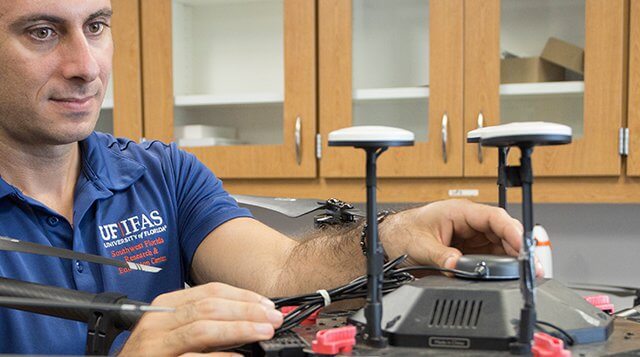As UF/IFAS joins a university-wide push to increase artificial intelligence research, its faculty will help solve major problems. Among them: ensuring crops taste good and resist diseases with the least environmental impact. UF/IFAS scientists are using AI to help solve chronic diseases, working with UF Health researchers. They’re also using drones to find diseased plants in large fields.
All the research – and its practical uses — begins with an overall artificial intelligence strategy for UF. The overarching goal of UF’s AI initiative is to harness the transformational potential for AI to benefit Florida, the United States and the world. UF is doing this by developing world-class academic and research leadership in artificial intelligence, integrating AI across academic disciplines, developing an AI-enabled workforce and fueling the state and national economy.
“From preserving the ecology of our coastlines and coastal communities to putting Americans back on track to live longer and healthier lives, our overarching goal in embracing this technology is to improve life on multiple fronts,” said UF Provost Joe Glover.
To help UF/IFAS in its AI research, many faculty will now be able to use the UF supercomputer known as the HiPerGator: the most powerful supercomputer in Florida, the most powerful university computer in the South and the third-fastest university supercomputer in the country.
Scott Angle, UF vice president of agriculture and natural resources, says UF/IFAS faculty work as teams to use AI to attack complex problems.
“Our engineers are world class, and they often work with computer models and huge data sets,” said Angle, administrative leader of UF/IFAS. “But they don’t work in silos. Indeed, using AI, many of our scientists will collaborate with our esteemed entomologists, horticulturalists, plant pathologists, soil scientists and more to take a global look at growing anything in Florida with reduced impact on the environment.”
For example, Arnold Schumann, a soil and water scientist at the Citrus Research and Education Center, works with Nathan Boyd, a weed researcher at the Gulf Coast Research and Education Center. They use machine vision-guided herbicide spraying to surgically remove unwanted weeds from rows of crops.
Yiannis Ampatizidis, an agricultural engineer at the Southwest Florida Research and Education Center, works with plant pathologist Pam Roberts. They fly drones 500 feet above the field and the AI computers sift through hundreds of images to almost instantly recognize and locate tomato diseases on plants with up to 99% accuracy.
Other UF/IFAS researchers some are reaching across to various departments and colleges at UF to collaborate on AI projects.
As an example, Peter DiGennaro, an assistant professor entomology and nematology, is working with Alina Zare, a professor in electrical and computer engineering, to find ways to quickly identify nematodes, which are agricultural pests that live in the soil.
Diane Rowland, professor and chair of agronomy, also is working with Zare on using imaging tools to help assess crop quality and stress, from in the field to harvested product.
Multiple UF/IFAS scientists received funding from the university’s AI Research Catalyst Fund. With the fund, UF is investing $1 million across the university with 20 faculty teams receiving $50,000 each. Projects include:
- Ray Huffaker, a UF/IFAS professor of agricultural and biological engineering, will use AI to help scientists forecast extreme weather events.
“We will formulate a novel symbiosis of AI, data processing and computing by a graphics processing unit to analyze and forecast real-world soil dynamics from field and remote-sensing big data,” Huffaker said.As a broad application, making AI work for real-world data can lead to quick forecasting of extreme environmental events — such as flooding, drought, landslides and fires — by AI-based early-warning systems.”
- Eric Triplett, professor and chair of microbiology and cell science, is collaborating with colleagues in the UF College of Medicine. They believe they can take data they’ve compiled thus far on chronic diseases in 1-year-old children and use AI to develop a model to accurately predict diseases, such as diabetes, long before any currently available diagnostic tools.
To further fuel AI agricultural progress at UF, the Provost’s AI Initiative will include five new UF/IFAS faculty members, including three new precision agriculture scientists.
New research will focus on using AI to extract information from images captured by drones and tractors for plant breeding applications, said Vance Whitaker, a UF/IFAS associate professor of horticultural sciences, who works at the Gulf Coast Research and Education Center.
“In this case, AI will be used to do things like assess plant growth, measure disease incidence and other traits,” said Whitaker. “This information capture is complex and needs to be automated, thus the importance of the AI. It’s basically precision agriculture for use in plant breeding.”
Another focus of UF/IFAS AI research will study robotic applications such as harvesting or precision herbicide application.
To follow UF/IFAS progress in AI research, please click here.
This story originally appeared on UF/IFAS Blogs.
Check out more stories on the UF A.I. Initiative.

